Content:
- Rocker
- Toe Pick
- Blade Styles
- Blade Profile
- Blade Recommendation
This post will be all about blades for the freestyle figure skater.
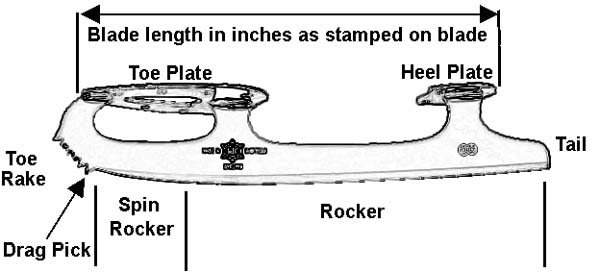
Rocker
Rocker is named for the blade’s ability to rock back and forth (rocking motion). A smaller radius results in more rocker. More of a read here.
7′ (foot) rocker – more curved blade, thus less surface contact with the ice.
Pro:
– more forgiving on spins
– smoother three turns; more mobile on the ice
– deeper edges
Con: less contact surface for edge control and landing jumps.
8′ (foot) rocker – less curved blade (flatter), hence more contact surface with the ice.
Pro:
– faster on the ice (if you see speed skates, they are virtually flat)
– better edge control so you don’t fall off the edge easily while preparing to jump
– more stability upon landing jumps (important for multiple revolution jumps)
Con: it is harder to find the ‘sweet’ spot for spins and three turns as the blade is less curved.
Generally, it is recommended you start off with the more curved blade (7′ rocker) until you are confident in your ability to centre spins. A flatter blade (8′ rocker) becomes important for performing triple and quadruple jumps. The flatter profile affords you more room and time to correct your landing, but you must be spot-on with your spin entries as the 8′ rocker provides less of a rocking motion, so it is harder to rock forward onto the spin rocker to begin your spin.
Spin rocker – this is the part of the blade you spin on. More on this below.
Toe Pick
The drag pick is the bottom pick.
The master picks are the front picks (for jumps).
The drag pick is the last thing to leave the ice on a jump (even on edge jumps); the first part of the blade to touch the ice on a jump landing; and, it slightly touches the ice on most spins.
On jumps, the toe picks bite into the ice to give the skater a stable entry for takeoff.
On landing, they provide a pivot point to use in controlling the impact, and position of your exit.
Toe picks are also used for pivots and pirouettes.
Jump-Spins, such as the Flying Camel, do use the toe picks to land the jump portion and then pivot onto the proper spin rocker edge for the spin portion.
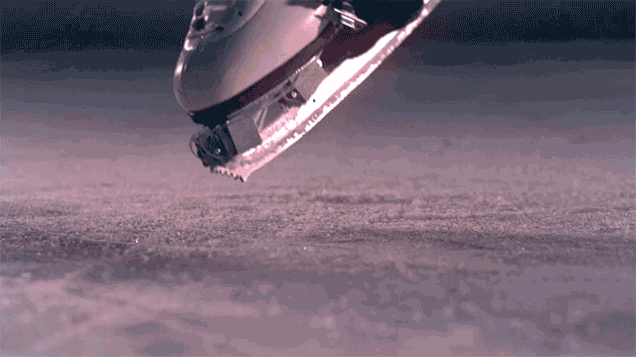
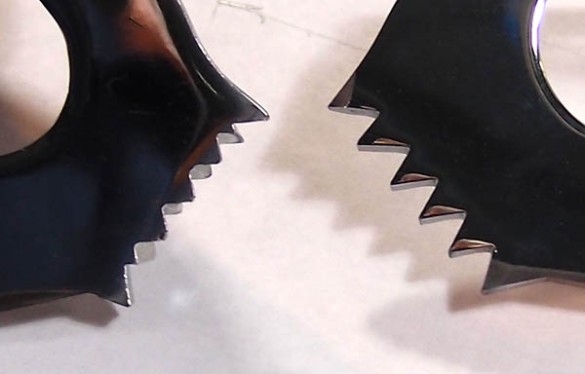
Cross Cut on the left – Straight Cut on the right
Straight Cut picks will allow the skater to quickly dig into the ice deep. This will allow skaters to get more height on their jumps. However, it may also make them lose momentum due to increased likelihood of slippage. Recommended more for advanced skaters who are confident in their jumps.
Cross Cut picks doesn’t dig as deeply into the ice, but will keep the pick from sliding on the ice. This is a wonderful feature for beginners to intermediates as it will allow you to work on your jumps with greater consistency and security.
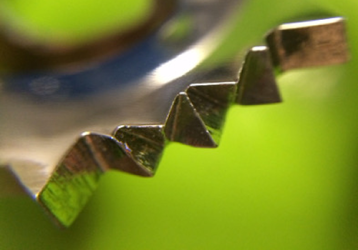
Larger toe picks increase jump height, but many professionals use smaller toe picks also.
K-pick – extra few picks at the sides of the standard toe-pick, supposedly to provide better control and anchorage on toe-jumps. This may result in increased height and distance on toe-loops and flips, but not the lutz. However, users have mentioned they have not noticed this difference, but noted that the K-pick offers slightly extra stability.
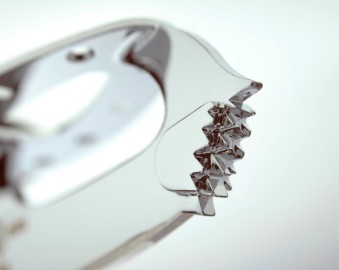
 Blade Styles
Blade Styles
Parallel – most blades run parallel; easiest to sharpen.
Parabolic – similar to parallel, but the blade is thinnest at the centre, which helps to centre your weight on this part of the blade
Tapered – the blade is thinner at the tail end of the blade, this results in less drag and friction, offering increased speed
Side honed – on the vertical side of the blade, there is some material removed, resulting in a lighter blade and more bite angle (deeper edges). I would not recommend ‘parabolic’ style blades for any side honed & tapered blades. You actually pay extra for one feature, but lose TWO features in return. I would only recommend them in place of parallel style blades.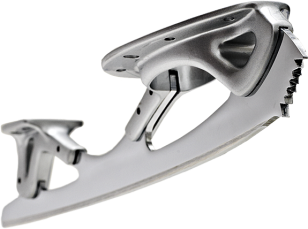
Revolution – originally made to be lighter than standard blades, skaters later found that the composite chassis (the base that holds the blade) had some flex to it. This elastic property cushioned impact forces, and you can read here why I consider this important. I own Revolution blades, and the cushioning is very noticeable; it helps me to perform jumps for longer, and my hips thank me for it!
The caveats to revolution blades are typically the cost and less room for catch foot maneuvers. If you plan to skate often, they are a good investment.
Blade Profile
Blade profile is the shape and placement of the spin rocker in relation to the rest of the blade. The point where the curvature of the rocker changes is the ‘sweet spot’. This point should fall just slightly forwards of the ball of your feet (where it bends). Hence, blades are designed to accommodate people’s foot differences in boots.![[blade.jpg]](https://scarletskater.files.wordpress.com/2017/06/33e43-blade.jpg?w=656)
You can see below on how forward this sweet spot is in different blade models. (These models are chosen as they can be purchased in ‘revolution’ style).
Note:
The glide/stroke section (the main rocker) is measured in feet!
The spin rocker is measured in inches.
Thus, a 27 inch radius is also 2.25 feet, which makes for a more curved section than a 7 or 8 foot rocker. (17 inch = 1.42 ft, while 12 inch = 1 ft)
The larger the radius of the spin rocker, the flatter this part of the blade is. You can see below that the Pattern 99/Aces have the flattest sweet spot. Meanwhile, the Gold Seal/Star/Professional have a curvy spin rocker, BUT the sweet spot is farther forward. Phantoms occupy the middle ground.
Does the curvature of the spin rocker matter? The most important part is the placement of the spin rocker, so make sure you have the correct blades fitted first (sweet spot just slightly ahead where the ball of your foot flexes). The curvature of the spin rocker has the same characteristics as discussed in the ‘rocker’ section above, but doesn’t matter hugely when it comes to the spin rocker. In fact, you’ll see that the further along the sweet spot is, the more curved the spin rocker HAS to be so you don’t end up spinning on the drag pick.
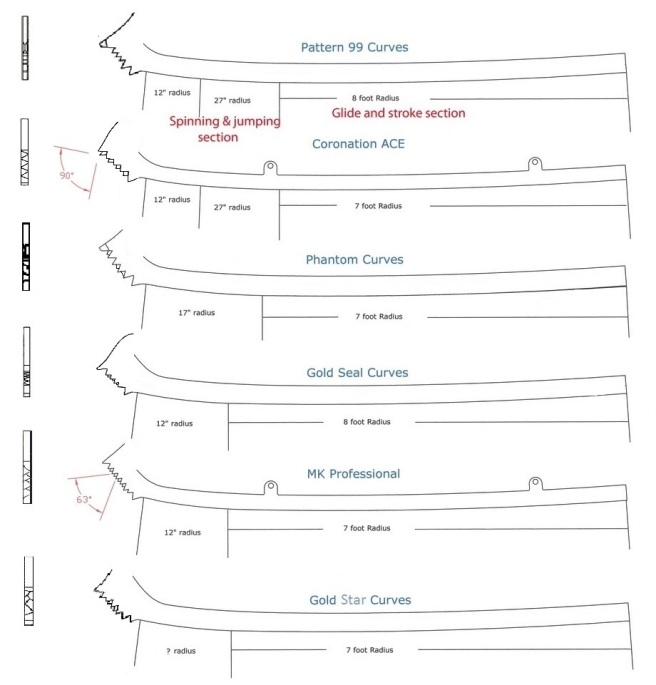
| Model | Brand | Rocker (ft.) | Style | Pick | Comments |
| Pattern 99 | John Wilson | 8′ | Parallel | Straight Cut | Large toe pick |
| Coronation Ace | John Wilson | 7′ | Parallel | Cross Cut | Beginner blade |
| Phantom | MK | 7′ | Tapered, Side Honed |
Cross Cut | Unique pick design* |
| Gold Seal | John Wilson | 8′ | Tapered, Side Honed |
Cross Cut | Increased stanchion height** |
| Professional | MK | 7′ | Parallel | Cross Cut | Beginner blade |
| Gold Star | MK | 7′ | Tapered, Side Honed |
Cross Cut | Designed for spins |
*Phantom toe rakes were designed for triple/quadruple jumps with an enlarged toe pick and cross hatched teeth for stability/security.
**Increased stanchion height simply means a taller blade (stanchions are the pillars on the skates). This is important for taller skaters to have more clearance (room/space) for edge work.
Take a look at another blog post of mine on blade profiles.
Blade Recommendations
Coronation Ace and MK Professional are designed for beginners (up to double lutz) as they have a more curved rocker to work on three turns and spins, while also having small cross cut picks to offer security on the ice while you work on your jump technique.
It is strongly recommended you when moving up a blade level, you move to a similar blade profile; the transition is much easier as the spin rocker is placed in the same location, and the curvature of this part is often kept the same.
Coronation Ace (7′ rocker, cross cut) users can move to:
Pattern 99 (8′ rocker, large straight pick) – same spin profile, but flatter blade and the most giant toe picks you’ve ever seen
Phantom (7′ rocker, unique cross cut) – similar profile, keeps that 7′ rocker for spins, the unique toe pick helps with different jumps
MK Professional (7′ rocker, cross cut) users can move to:
Gold Seal (8′ rocker, cross cut) – same spin profile, but flatter blade
Gold Stars (7′ rocker, large cross cut) – same spin profile, same 7′ rocker for easier spins, and larger picks for increased jump height
As seen above, high-end models can be found with:
– 7′ or 8′ rockers
– Large or small toe picks
– Straight cut or cross cut toe picks
All these features are available on both (1) low-end models, and (2) high-end models.
So, what do you actually pay for when you buy a more expensive blade??
High-end (expensive) blades justify their price due to:
- More complex features, such as side-honing and tapering of the blade
- Chassis being made of lightweight (carbon fibre, aluminum) or tougher material (titanium)
- Being made of higher quality steel. The great thing about MK/John Wilson blades is that their blades are all made of Sheffield Steel, although their higher end models are supposedly even tougher
Higher quality steel results in fewer sharpening sessions, so you may actually save money in the long-term over cheaper models. Blades generally last a number of years before needing to be replaced. Furthermore, higher grade steel will bear the punishment from jumps better. MK Phantoms and Gold Stars are hand brazed (where the different blade parts are joined together) with bronze (increased strength), while their other lineups (and John Wilsons’), are silver soldered (still strong, but slightly less so than bronze).
List of major manufacturers
HD Sports ( John Wilson; Mitchell & King (MK) ) – England
Jackson (Ultima) – Canada (high-end models); China (cheaper models)
Riedell (Eclipse) – United States
Jerry’s (ISE) – Canada
Paramount – United States
John Wilson and MK blades lead the market for blades worn by professionals. In fact, John Wilson has been a blade (knife) manufacturer in the 1600s before pivoting to making figure blades.
Take a look at the comparison of blades offered by the above manufacturers.
For detailed explanations of topics discussed in this post, try the following pages:
All About Figure Skating Blades
A Guide to Skating Blades
Skate Sharpening Information
Understanding Radius of Hollow
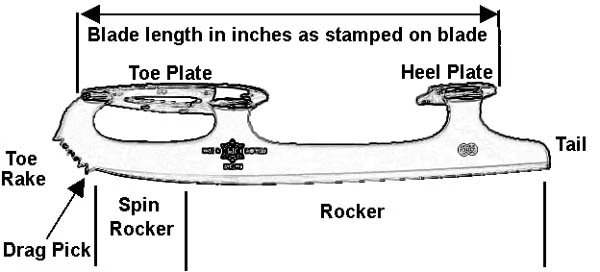
2 thoughts on “Choosing Figure Skating Blades”